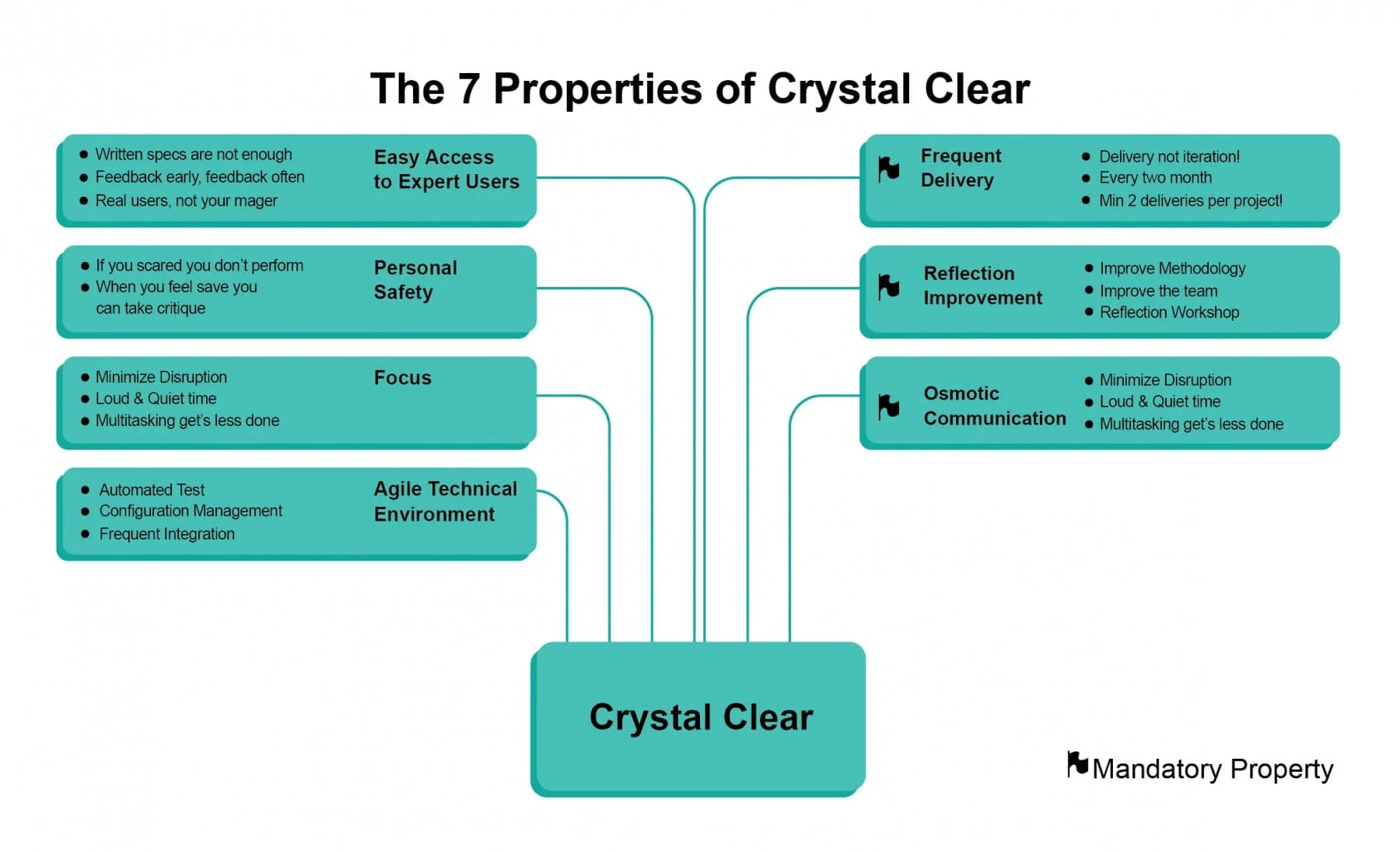I bet you had no idea I am talking about the software development methodology called Crystal Clear. If you have started in the field after 2004, you may as well never have heard of it. Despite its relative obscurity in the modern product development world dominated by Agile, Crystal Clear offers unique perspectives and practices that can significantly benefit small teams. Let’s dive into what Crystal Clear is, compare it with other Agile methodologies, and explore its potential relevance today.
What is Crystal Clear?
Crystal Clear is part of the Crystal family of methodologies developed by Alistair Cockburn. Designed specifically for small, co-located teams of 2 to 8 people, it emphasizes human-centric processes and adaptability. First introduced in the early 2000s, Crystal Clear was created to optimize software development through frequent delivery, reflective improvement, and close communication.

Historical Context
In the late 1990s and early 2000s, the software development community was exploring various lightweight methodologies to address the rigidity and inefficiency of traditional processes. Alistair Cockburn’s Crystal family emerged as a response, focusing on tailoring practices to the unique needs of each project. Crystal Clear, specifically, targeted small teams where close collaboration and communication could thrive.
Overview of the Methodology
Crystal Clear is characterized by several key features:
- People-Centric Approach: It emphasizes the importance of team members’ personal safety, well-being, and communication.
- Core Properties: Includes frequent delivery of working software, reflective improvement practices like retrospectives, and osmotic communication, where team members stay informed through casual, overheard conversations.
- Flexibility: It is not prescriptive about specific practices, allowing teams to adapt methods based on their context and needs.
- Frequent Delivery: Prioritizes delivering useful, working software within a timeframe of one to three months.
Apple to Apple Comparison with Agile
To understand Crystal Clear’s place in the Agile world, let’s compare it to widely adopted Agile methodologies like Scrum and Extreme Programming (XP).
Structure and Roles
- Crystal Clear: Defines basic roles such as Team Members and Project Lead but allows flexibility in role definitions.
- Scrum: Specifies clear roles like Scrum Master, Product Owner, and Development Team.
- XP: Emphasizes technical roles and practices, including continuous customer involvement.
Iterative Development
- Crystal Clear: Encourages frequent delivery within flexible timeframes.
- Scrum: Utilizes fixed-length sprints, typically 2-4 weeks.
- XP: Works in short iterations, often 1-2 weeks.
Communication
- Crystal Clear: Relies on osmotic communication and informal exchanges.
- Scrum: Uses structured meetings such as daily stand-ups, sprint reviews, and retrospectives.
- XP: Promotes pair programming and continuous feedback.
Crystal Clear Sounds Pretty Awesome. But Why the Heck Have We Never Heard About It? Why Did Agile Win?

Despite its strengths, Crystal Clear did not gain the same traction as other Agile methodologies. Here are some possible reasons why:
Early Industry Momentum
Scrum and XP gained early momentum and industry support. This early adoption created a network effect where more resources, training, and case studies were available, making them more accessible to new adopters.
Clarity and Prescriptiveness
Scrum and XP offer clearer, more prescriptive frameworks with defined roles, ceremonies, and artifacts. This can be advantageous for teams seeking structured approaches with well-defined practices.
Standardization and Certification
Agile frameworks like Scrum have established certifications and training programs (e.g., Certified Scrum Master), which contributed to their popularity and perceived credibility in the industry.
Weaknesses of Crystal Clear
- Visibility: Crystal Clear lacked the widespread visibility and promotion that Scrum and XP enjoyed.
- Community and Resources: Limited resources and community support compared to other Agile methodologies.
- Adaptability: While flexible, its lack of prescriptive guidance could be seen as a disadvantage for teams needing clear direction.
Here’s How We Revamp Crystal Clear to Compete with Agile (The Renewed Crystal Clear)
To revitalize Crystal Clear and make it competitive with other Agile methodologies, we can enhance its approach:
- Clear Structure and Roles: Define basic roles such as Team Members, Project Lead, and Executive Sponsor with flexibility for adaptation.
- Iterative Development: Adopt an iterative approach with lightweight milestones for feedback and adaptation.
- Adaptive Planning: Encourage regular adaptive planning sessions to prioritize tasks and adjust plans.
- Emphasis on Communication and Collaboration: Implement daily stand-ups and periodic workshops for continuous feedback and improvement.
- Minimalist Documentation: Focus on essential documentation to support decision-making and knowledge sharing.
- Tailored Practices (Crystal Colors): Retain the concept of Crystal Colors to offer tailored practices based on project size and criticality.
- Feedback Loops and Retrospectives: Regular feedback loops and retrospectives to reflect on performance and identify improvement areas.
- Support for Distributed Teams: Provide guidelines for effective collaboration and communication across geographical boundaries.
Analysis of Where Crystal Clear Could Be a Suitable Methodology
Crystal Clear can be particularly suitable in the following contexts:
- Small Teams: Ideal for teams of 2 to 8 people, emphasizing close-knit collaboration and communication.
- High Flexibility Needs: Suitable for projects requiring a high degree of adaptability and customization of practices.
- Human-Centric Environments: Beneficial in environments prioritizing personal safety, team well-being, and effective communication.
- Innovative Projects: Well-suited for projects that benefit from frequent delivery and reflective improvement practices.
While Crystal Clear may not be as well-known as other Agile methodologies, it offers unique benefits, particularly for small, flexible, and human-centric teams. By renewing its approach and integrating clear structures and iterative practices, Crystal Clear can become a viable alternative in the Agile world. Understanding its strengths and areas for improvement allows us to appreciate its potential and adapt it to modern software development needs.
I am recalling my days as a Scrum Master… going easy on the ritual culture, encouraging spontaneity and creativity, which Crystal Clear fully supports. To me, it would be a no-brainer; I would choose Crystal Clear.
Useful Crystal Clear Resources
Crystal Clear: A Human-Powered Methodology for Small Teams by Alistair Cockburn –https://amzn.to/4bSginn – This book provides a comprehensive overview of the Crystal Clear methodology, detailing its principles, practices, and application to small, co-located teams.
Agile Software Development: The Cooperative Game by Alistair Cockburn – https://amzn.to/45sQz2g – This book discusses the broader Crystal family of methodologies, including Crystal Clear, and explores the cooperative game model of software development.
Alistair Cockburn’s Official Website – http://alistair.cockburn.us – Alistair Cockburn’s official website, which includes articles, case studies, and other resources related to the Crystal methodologies and Agile development.
Martin Fowler’s Bliki – https://martinfowler.com/articles/newMethodology.html – Martin Fowler’s blog entry that gives a concise summary of Crystal Clear, its context, and its place within the Agile landscape.
The Crystal Clear methodology explained – https://www.iapm.net/en/blog/crystal-clear/ – IAPM article about Crystal Clear.
InfoQ – https://www.infoq.com/news/2010/09/interview-alistair-part01/ – An interview with Alistair Cockburn on InfoQ, discussing Crystal Clear and its role in the Agile methodology landscape.




No responses yet